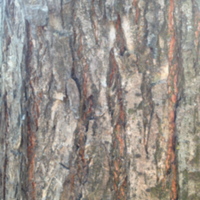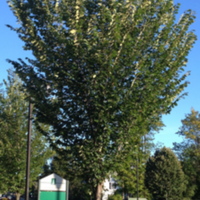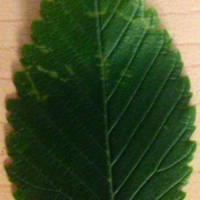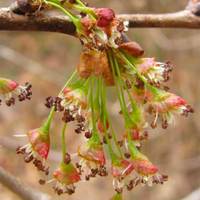American Elm : Physical Description

Here is the brownish-gray bark color of the American elm. This tree is young because the lighter brown ridges in the bark are straight. (Kathryn Maitland, September 20, 2013)
“’Now it seems the Elm-stake shooted, in the maiden’s body rooted,
And with leaves and tender branches raise its head above the ground;
And so wondrous was its growing, that its noble head was showing
Very shortly as the highest object in the country round…’”
(Clouston & Stansfield, 1979, p. 56).
-Maud’s Elm by Byrne
This quote describes the grandness and beauty of the Ulmus americana. The American elm (Ulmus americana) is also known as the American white elm or the white elm. This is mainly from its creamy white wood. Before Dutch elm disease (a disease that killed most of the elms in the United States and Europe), American elms could grow as big as 125-150 feet tall and have trunks that were as large as 7 ft in diameter. (This means that American elms would be as tall as an average 12-14-story building; taller than any building in Vermont! An American elm could be taller than three Davis Centers stacked on top of each other, if each floor in the Davis Center is an average height.) After Dutch elm disease, the tallest trees are 80 feet and their canopy can be as wide as 60 feet. (These trees would be about 1.5 Davis Centers, using the same conversation.) The tallest trees after Dutch elm disease are about half the size of the trees before the disease. However, now most American elms die by the time they reach 40 feet because the species is unable to survive as well after Dutch elm disease. (The average trees are as tall as three floors in the Davis Center, when the same conversations are used.) The average height of the American elm is less than one third as tall as the tallest American elms before Dutch elm disease. This shows how the height of American elms has shrunk since Dutch elm disease plagued this species.
Defining Features:
Tree Shape: The American elm tree is a vase shaped tree because the trunk is straight and divides into a group big branches, about five feet up the tree. The canopy practically makes a V-shape, so it is very full and wide at the top of the tree, but the canopy gets smaller and skinnier as one looks down the tree to where the branches start to form. The smaller branches and twigs of the American elm point up towards the sky, to exaggerate the V-shape of the tree. (If the tree were a huge vase of flowers, the flowers would be popping out of the top of the canopy.) As the tree ages, the bottom branches start arching more towards the ground, so the canopy starts to look like a fan. (When the tree gets older, the shape of the tree can still be thought of a vase of flowers; however there are either too many flowers in the vase or the flowers in the vase are dying because some of the flowers would be drooping down to the side.)
Bark: The bark is a brownish-gray color. There are flattened ridges in the bark that are straight on younger trees and intertwine on older trees.
Leaves: American elms have alternate leaves that have an asymmetrical base. The leaves have an elliptical to ovate shape. The edges of the leaves are doubly serrated. The leaves have veins that run straight from the center of the leaf to the edge of the leaf. In the fall, the leaves turn golden, yellow, and chartreuse.
Flowers: The flowers are a creamy brownish red. They do not look like a typical flower because these flowers do not have any petals. Instead there is a long, drooping stem that connects the small flower to the twig, so usually the flowers sway in the wind. The flowers grow in clusters of 3-5 and come out in early spring before the leaf buds.
In order to reach their greatest growing potential, American elms like to grow in moist, warm, and fertile soils. American elms can handle variable pH differences of the soil and they can tolerate dry soil because these trees can be found growing in open fields. Ulmus americana also needs partial to full sunlight to reach maximum growing potential. American elms are one of the first trees to start growth in the spring. Their buds start swelling the first few warm days of January and February. Then in March and April their flowers start to bloom.



